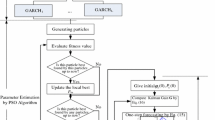Abstract
Adaptive support vector regression (ASVR) applied to the forecast of complex time series is superior to the other traditional prediction methods. However, the effect of volatility clustering occurred in time-series actually deteriorates ASVR prediction accuracy. Therefore, incorporating nonlinear generalized autoregressive conditional heteroscedasticity (NGARCH) model into ASVR is employed for dealing with the problem of volatility clustering to best fit the forecast’s system. Interestingly, quantum-based minimization algorithm is proposed in this study to tune the resulting coefficients between ASVR and NGARCH, in such a way that the ASVR/NGARCH composite model can achieve the best accuracy of prediction. Quantum optimization here tackles so-called NP-completeness problem and outperforms the real-coded genetic algorithm on the same problem because it accomplishes better approach to the optimal or near-optimal coefficient-found. It follows that the proposed method definitely obtains the satisfactory results because of highly balancing generalization and localization for composite model and thus improving forecast accuracy.
Similar content being viewed by others
References
Box GEP, Jenkins GM, Reinsel GC (1994) Time series analysis: forecasting & control. Prentice-Hall, New Jersey
Deng JL (1982) Control problems of grey system. Syst Control Lett 1(5):288—294
Chang BR (2003) A study of non-periodic short-term random walk forecasting based on RBFNN, ARMA, or SVR-GM(1,1,tau) approach. In: Proceedings of the IJCNN, pp 254—259
Vapnik V (1995) The nature of statistical learning theory. Springer-Verlag, New York
Chang BR (2005) Compensation and regularization for improving the forecasting accuracy by adaptive support vector regression. Int J Fuzzy Syst 7(3):110—119
Bellerslve T (1986) Generalized autoregressive conditional heteroscedasticity. J Econ 31:307—327
Gourieroux C (1997) ARCH models and financial applications. Springer-Verlag, New York
Nielsen MA, Chuang IL (2000) Quantum computation and quantum information. Cambridge University Press, London, ISBN 0 521 63503 9
Anguita D, Ridella S, Rivieccio F, Zunino R (2003) Training support vector machines—a quantum-computing perspective. In: International joint conference on neural network IJCNN03, pp 1587—1592
Durr C, Hoyer P (1996) A quantum algorithm for finding the minimum, http://arxiv.org/abs/quant-ph/9607014
Fletcher R (1987) Practical methods of optimization, 2nd edn. Wiley and Sons, New York
Deutsch D, Jozsa R (1992) Rapid solution of problems by quantum computation. In: Proceedings of the Royal Society, London, A439, pp. 553—558
Grover LK (1996) A fast quantum mechanical algorithm for database search. In: Proceedings of the 28th annual ACM symposium theory of comp. ACM Press, pp 212—219
Boyer M, Brassard G, Hoyer P, Tapp A (1998) Tight bounds on quantum searching. Fortschritte Der Physik
Cristianini N, Shawe-Taylor J (2000) An introduction to support vector machines. Cambridge University Press, London
Kreyszig E (1999) Advanced engineering mathematics, 8th edn. Wiley, New York
Chang CC, Lin CJ (2003) LIBSVM: a library for support vector machines, http://www.csie.ntu.edu.tw/~cjlin/papers/libsvm. pdf
Murphey YL, Chen ZH, Putrus M, Feldkamp L (2003) SVM learning from large training data set. In: Proceedings of the IEEE IJCNN, pp 860—2865
Hamilton JD (1994) Time series analysis. Princeton University Press, New Jersey
Hentschel L (1995) All in the family: Nesting symmetric and asymmetric GARCH models. J Finan Econ 39:71—104
Huang YP, Yu TM (1997) The hybrid grey-based models for temperature prediction. IEEE Trans. SMC-Part B: Cybernetics 27(2):284—297
Mori H, Kosemura N, Ishiguro K, Kondo T (2001) Short-term load forecasting with fuzzy regression tree in power systems. In: Proceedings of the IEEE international conference on SMC, pp 1948—1953
Chang BR (2006) Applying nonlinear generalized autoregressive conditional heteroscedasticity to compensate ANFIS outputs tuned by adaptive support vector regression. Fuzzy Sets Syst 157(13):1832—1850
Pshenichnyj BN, Wilson SS (1994) The linearization method for constrained optimization. Springer, New York
Ono I, Kobayashi S (1997) A real-coded genetic algorithm for function optimization using unimodal normal distribution crossover. In: Proceedings of the 7th international conference genetic Algorithms, pp 246—253
Diebold FX (1998) Elements of forecasting. South-Western, Cincinnati.
FIBV FOCUS MONTHLY STATISTICS (2005) International Stock Price Index
Ljung GM, Box GEP (1978) On a measure of lack of fit in time series models. Biometrika 65:67—72
Central Weather Bureau, Typhoon Moving Trace Inquire, Taipei, Taiwan, 2005
Author information
Authors and Affiliations
Corresponding author
Additional information
Bao Rong Chang is currently an Associate Professor in the Department of Computer Science and Information Engineering at National Taitung University in Taitung, Taiwan. He completed his BS degree from the Department of Electronic Engineering, Tam Kang University, Taiwan. In 1990, he earned his ME degree from the Department of Electrical Engineering, University of Missouri-Columbia, USA, and his Ph.D. in 1994 at the same University. His current research interests include Intelligent Computations, Applied Computer Network, and Financial Engineering.
Hsiu-Fen Tsai is currently a Senior Lecturer in the Department of International Business at Shu Te University in Kaohsiung, Taiwan. She completed her BA degree from the Department of International Business, National Taiwan University, Taiwan. In 1995, she earned her MBA degree from the Department of Business Administration, National Taiwan University, Taiwan. At present, she is a Ph. D. Candidate in Department of International Business since 2004 at the same University. Her current research interests include Intelligent Analysis of Business Models and Applications of Strategy Management.
Rights and permissions
About this article
Cite this article
Chang, B.R., Tsai, HF. Composite of adaptive support vector regression and nonlinear conditional heteroscedasticity tuned by quantum minimization for forecasts. Appl Intell 27, 277–289 (2007). https://doi.org/10.1007/s10489-006-0036-9
Received:
Accepted:
Published:
Issue Date:
DOI: https://doi.org/10.1007/s10489-006-0036-9




